A recently excavated archaeological site in the Tek Tek Mountains in the Şanlıurfa Province of Anatolia is shedding new light on the ingenuity and astonishing creativity of the Neolithic people from this part of southeast Turkey. The site in question lies approximately 25 miles southeast of its more famous sister site, Göbekli Tepe. Karahan Tepe has been dated to about 11,400 years old and has numerous worked stone artifacts with at least 250 monoliths, mostly T-pillars, as well as many unique stone carvings and designs.
Like at Göbekli Tepe , this site is covered with many strange depictions of humans, symbols, and animals, sometimes involved in very odd activities, and not least of all, an amazing 3D portrayal of a human head with a serpentine neck emerging from rock, one of the most striking elements of the site. Many artifacts are now on display at the Archaeology Museum in Şanlıurfa, where an exhibition of the finds can be seen.
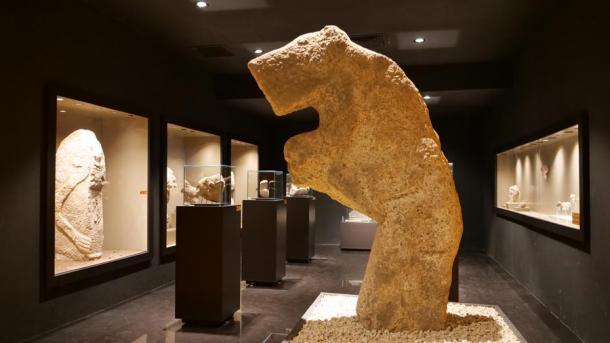
Artifacts from Karahan Tepe on display at the archaeology Museum in Şanlıurfa. (Author provided)
Karahan Tepe Emerges from the Landscape
Karahan Tepe is a very strange Pre-Pottery Neolithic complex built halfway up a huge rocky hill. When viewing the horizon from its peak, it feels like it is in the middle of nowhere. Furthermore, there are several sites of a similar age and style being excavated right now in a zone called ‘Tas Tepeler,’ meaning ‘Stone Hills’. This covers an area of 124 miles in width. Karahan Tepe is one of 11 sites under investigation. Göbekli Tepe being the primary site, it the only one currently open to the public.
Hugh first explored the un-excavated site of Karahan Tepe in 2014 with Andrew Collins and a group of Megalithomaniacs, with two further visits in 2015, and more recently with JJ Ainsworth in 2018. During these visits we could only see the tops of T-pillars on the surface of the hill, lots of them. Also on view is an 18ft unfinished T-shaped monolith below the hill on the western edge and some relief carvings on a few stones were visible. Although it had yet to be excavated this did not take away from the majesty of what lay before us. For many years we were always discussing what was going to be found, so we are delighted that this treasure trove was right under our feet. Having said that, only a small section of Karahan Tepe has been revealed so far, so more surprises will no doubt be in store in the near future.
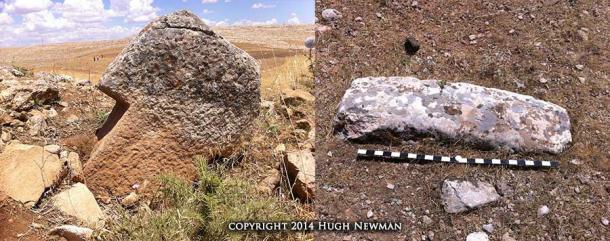
How Karahan Tepe looked before being excavated, with T-Pillars just about exposed above ground level . (Author provided)
When we visited in October 2018, we were met by the very kind landowner, who invited us in for tea, and then took us on an exploratory walk across the landscape. The tea was excellent, but the stroll was even better. As we slowly made our way up the hill, we could see the tops of T-shaped pillars jutting up from the ground anxious to escape their prison of dirt and rubble. They seemed to be everywhere, and it took everything we had to not drop to our knees, and begin helping to free them from their subterranean captivity. We cautiously continued exploring as our minds raced with ideas and imaginative thoughts of what might lie beneath our feet. Could this site be as awe-inspiring as Göbekli Tepe? What mysteries would eventually be revealed here?
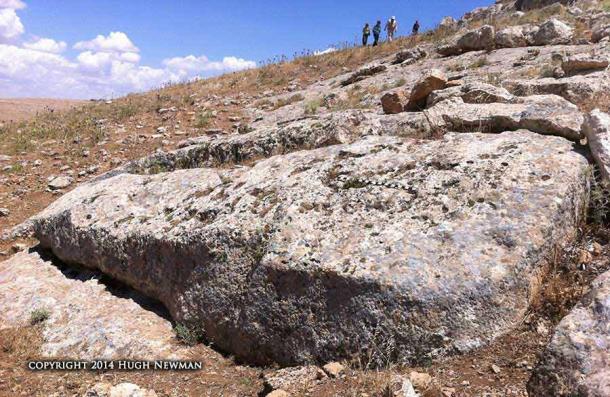
The unfinished T-Shaped pillar on the west slope of Karahan Tepe. (Author provided)
In 2019 excavation finally began, led by archaeologist Prof. Necmi Karul, associate professor in the Prehistory Department of İstanbul University. As his team slowly uncovered the northern slopes of the stone hill, some astonishing discoveries began to be made. One of the most fascinating elements of the excavation was the ‘ hypogeum’ style chambers and pits, and the way the western side of the main 75 ft (23 meter) enclosure had what appeared to be T-Pillars carved out of solid bedrock, whilst others in the circle were free-standing. The site looks like it was damaged (or decommissioned) before it was deliberately, and very carefully, covered over.
Necmi Karul, the head archaeologist wrote a recent paper examining the techniques and implications of this process. He focused on the AB pit, a 7m by 6m (23ft by20ft) shaft with 11 standing pillars and a protruding carved head on the western wall. One of the pillars is free-standing with what looks like a human and animal combination.
The main feature is the protruding head which seems completely out of place, with a unique, and quite intense expression, who also has an elongated neck that may represent a serpent. On the southeast edge of the pit is a 70cm (27.5 inch) wide portal hole, that leads out to the main 75 ft enclosure.
Like at Göbekli Tepe, holed stones and evidence of other portals have been unearthed at Karahan Tepe, but why place this one, which is carved out of the bedrock, in this exact position?
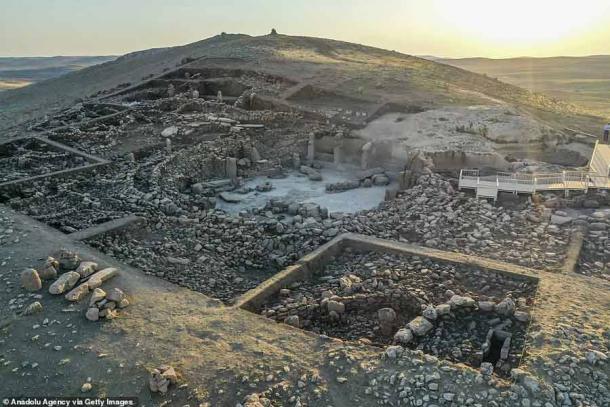
Official aerial shot of the excavated site. Courtesy: Anadolu Agency.
JJ Ainsworth and Hugh Newman had the chance to visit the site once again on 20th December 2021 early in the morning and had a feeling there may be something significant relating to the Winter Solstice Sunrise at the site.
Andrew Collins has outlined a theory that there was a Summer Solstice Sunset alignment going through the site (oriented along the primary direction of the second unfinished hypogeum pit), which revealed, that in around 9000 BC, the Milky Way would be vertical above the horizon soon after sunset (see https://youtu.be/GSlGuiIINDA). If we look in the other direction, we have the orientation of the Winter Solstice sunrise.
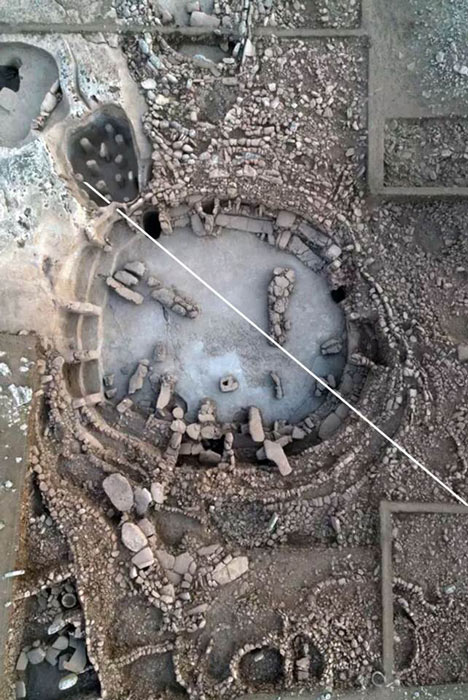
The sunrise line as it would go through the portal stone to illuminate the stone head. In 9,400 BC it may have illuminated the full face. (Author provided)
And Then There Was Light
We excitedly arrived at the site early with only the cold and piercing wind threatening to stop us. It didn’t, and we were greeted by the guardian of Karahan Tepe, Ismail. We had met Ismail several times before on our previous visits. He welcomed us, we drank some tea very quickly and headed up the hill, past the newly constructed visitors center just as the clouds dispersed and the sun shone through illuminating some of the enclosures. The AB pit, however, appeared to have no light hitting it yet, except a small blade of sunlight highlighting one side of the protruding head.
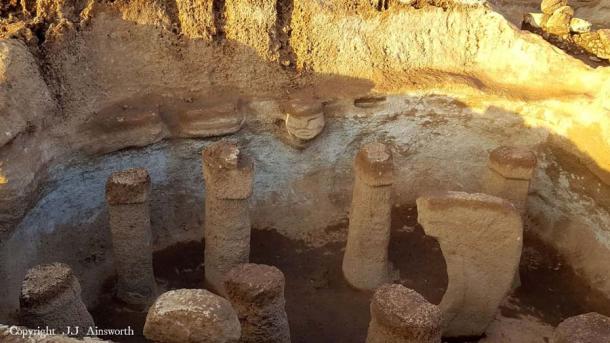
First light illuminates the side of the stone head. (Author provided)
We watched in anticipation as the light continued to illuminate the serpentine neck, the cheek, and then it moved towards the mouth, which, in some prehistoric traditions, was considered a divine life source. It was all illuminated with light shining only through the portal stone. As the sun rose higher, more of the stone cranium began to be bathed in light, but the other 11 pillars remained in the shade, waiting for their time to shine. JJ set up a camera to film the process, while Hugh got shots from as many angles as possible, praying the cloud cover would stay away.
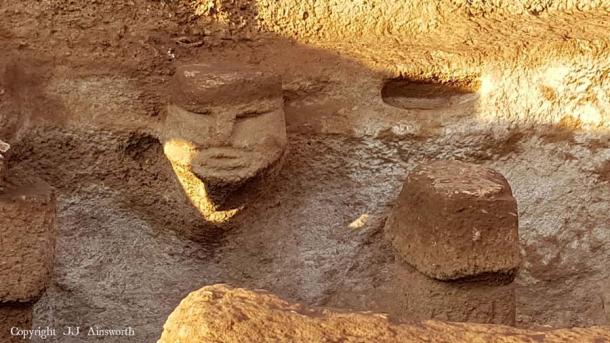
The light coming through the portal now illuminates the lower part of the face. (Author provided)
After one more hour, the top part of the portal was now blocking the light, but minutes later, the forehead and scalp were in full sunlight. Was this deliberate? Was it designed to illuminate the face, pause for a moment of darkness, then reveal a ‘halo’ of light as the final stage around the top of the head, before the sunlight lit up the other pillars? As the sun moved westwards, darkness once prevailed in the AB pit, or more appropriately what Andrew Collins calls ‘The Pillar Shrine ’.
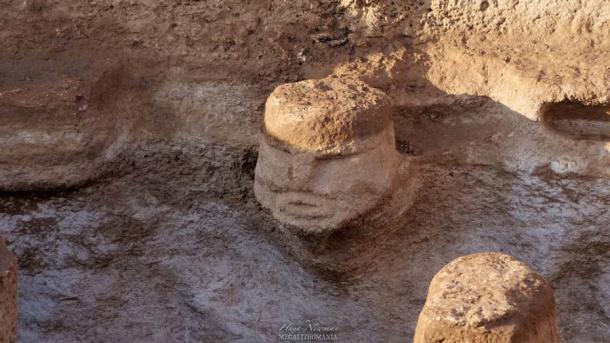
The sun now only illuminates the top of the head. (Author provided)
It appears from the layout of the 75ft enclosure that the sun would have beamed through between the two central pillars when they were upright, and then through the portal, before hitting the stone head. In 9,400 BC with the movement of ‘Precession,’ the sun may have been more in line and illuminated the head fully. However, more research needs to be done on this to conclude if our observations in the modern day would work accurately when the site was laid out and designed. We were quite possibly the first observers of this phenomenon in the last nine or ten thousand years. The weather gods were on our side, and it felt like we were witnessing one of the biblical gods, or one of the ‘Shining Ones’ who had emerged from his or her slumber to gaze upon a very different world.
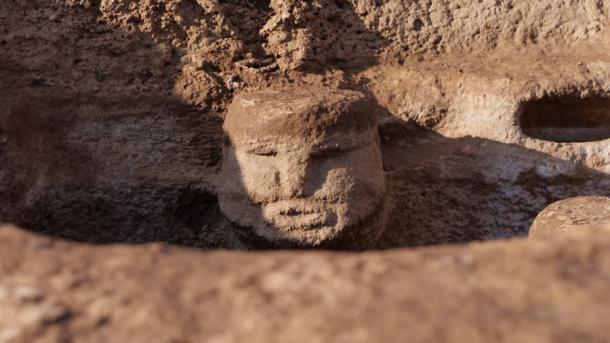
Fully illuminated stone head at Karahan Tepe. (Author provided)
Winter Solstice Regeneration At Karahan Tepe
If we look to the evidence from archaeological artifacts, and within the stories and myths of the area, Karahan Tepe is possibly a site involved with healing and regeneration, and this is based on many factors. A few of these are the existence of the many large cup-marks at the site, which can be thought of as miniature wells, and relate to the divine life source of the ancient goddess.
The ancients believed the rain that collected in these cup marks had healing properties, because moisture was believed to always be from the goddess. They would rub the liquid onto injured areas of the body or drink it hoping to ease their afflictions. Still, today, in Greece there are celebrations that revere the prehistoric goddess and her healing aspects in a similar manner, and ‘well water events’ or ‘ring dances,’ performed by women, occurred in Ireland even up to the 19th century.
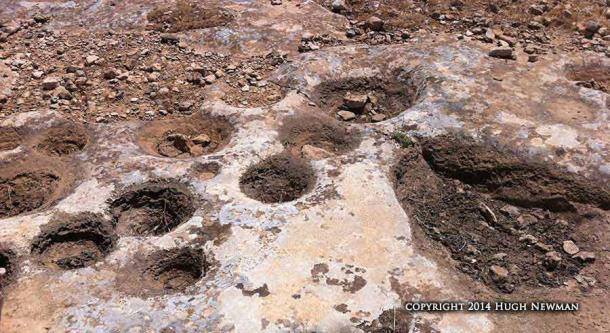
Cup-marks at Karahan Tepe. (Author provided)
The 3D anthropomorphic head may be a depiction of the goddess in her regeneration aspect. If we take into account the phallic-like obelisks being related to fertility then it makes sense that the head would belong to a goddess. The ancients knew that the unionization of male and female was needed to seed life, but as it was the woman who gave birth she was thought of almost as magical and played the biggest part in the life-creating process. In fact, it seems that these particular sites were chosen for their roundness, which resembles a fully pregnant woman’s stomach. Perhaps the phallic-like structures combined with the chosen rounded female hill was an attempt at fertilization to regenerate life and to heal. If she could bring a whole new life form into the world, then perhaps the goddess could also easily heal the illnesses of those already in existence.

Now that we have witnessed and know for a fact that the Karahan site is one related to the Winter Solstice, this all firmly puts the site in line with other well-known goddess sites found across the world, many also aligned with the solstices and equinoxes. All of this suggests at least one purpose of the site as possibly being a place of regeneration and healing.
We believe this is but one single alignment of sun/shadow play that is designed within the site. For a long time, we have been convinced that 3D relief carvings, like those at Göbekli Tepe and Karahan Tepe, were deliberately placed to reveal a story as the sun (and the bright moon) circles through the sky, illuminating only certain artistic imagery at specific times and dates, as though a story is unfolding. Similar effects can be seen at Sillustani in Peru and even on the polygonal walls of Sacsayhuaman, the carved monoliths of Stonehenge in England, and at the Osirion in Egypt. It appears that subtle symbolic messages reveal themselves through the use of stone, light and detailed observation, so could Karahan Tepe, when fully excavated, one day reveal the full story of who really built the site and what knowledge they have for us?
Top image: Overview of Karahan Tepe with the Winter Solstice alignment. Source: Author provided
By Hugh Newman and Jj Ainsworth
Hugh Newman is the author of Earth Grids (2008), Stone Circles (2017) and co-author of Giants On Record: America ’s Hidden History, Secrets in the Mounds and the Smithsonian Files (2015), The Giants of Stonehenge and Ancient Britain (2021), Megalith: Studies In Stone (2018) and Geomancy (2021). He is a world explorer, Megalithomania Conference organiser and tour host and has appeared on Ancient Aliens (History) and other TV shows. He lives next to Stonehenge in Wiltshire, UK. www.megalithomania.co.uk
JJ Ainsworth is a researcher and explorer based in the US, who is an expert on ancient symbolism and connections between sites worldwide. She has featured on numerous radio shows, has published articles on www.ancient-origins.net, and presented at Megalithomania in Glastonbury and the Origins Conference in London. www.youtube.com/c/megalithicmaiden
Explore Karahan Tepe and Ancient Turkey in September 2022. Details here; http://www.megalithomania.co.uk/turkey2022.html
Related posts:
Views: 0
 RSS Feed
RSS Feed















 December 23rd, 2021
December 23rd, 2021  Awake Goy
Awake Goy  Posted in
Posted in  Tags:
Tags: 
















